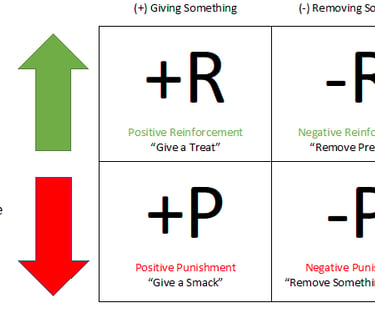NEW TSHIRTS AND K9 DRAGON FACTORY BRAND CLOTHING
Four Quadrants Of Behavior
Quick Reference of 4 Quads Behavior
K9 TRAINING
B Anderson
5/30/20231 min read


Here are the details about each quadrant for quick reference:
Positive Reinforcement (R+):
Description: Adding a desirable stimulus to increase the likelihood of a behavior being repeated.
Example: Giving a treat to a dog for sitting on command.
Effect: Reinforces and strengthens the desired behavior.
Positive Punishment (P+):
Description: Adding an aversive stimulus to decrease the likelihood of a behavior being repeated.
Example: Giving a firm "no" or a light physical correction when a dog jumps on someone.
Effect: Discourages and reduces the occurrence of the undesired behavior.
Negative Punishment (P-):
Description: Removing a desirable stimulus to decrease the likelihood of a behavior being repeated.
Example: Ignoring a dog's demand barking and turning away until the barking stops.
Effect: Decreases and weakens the undesired behavior.
Negative Reinforcement (R-):
Description: Removing an aversive stimulus to increase the likelihood of a behavior being repeated.
Example: Stopping leash tension when a dog stops pulling.
Effect: Reinforces and strengthens the desired behavior by removing an unpleasant stimulus.
Please note that positive reinforcement (R+) and negative punishment (P-) are generally recommended as more effective and humane training methods. Positive punishment (P+) and negative reinforcement (R-) should be used with caution and preferably under the guidance of a professional dog trainer, as they can have unintended consequences if not applied correctly.


